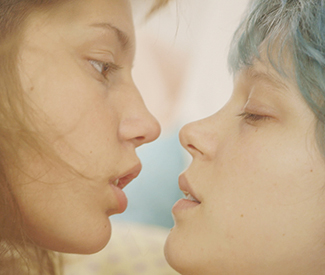arts@sfbg.com
FILM The stars say the director was brutal. The director says he wishes the film had never been released (but he might make a sequel). The graphic novelist is uncomfortable with the explicit 10-minute sex scene. And most of the state of Idaho will have to wait to see the film on Netflix.
The noise of recrimination, the lesser murmur of backpedaling, and a difficult-to-argue NC-17 rating could make it harder, as French director Abdellatif Kechiche has predicted, to find a calm, neutral zone in which to watch Blue is the Warmest Color, his Palme d’Or–winning adaptation (with co-writer Ghalya Lacroix) of Julie Maroh’s 2010 graphic novel Le Blue Est une Couleur Chaude.
And yet … this is not Gigli (2003), despite the slimmest of Venn diagram overlays (lesbians). In the states, at least, Blue stars Adèle Exarchopoulos and Léa Seydoux (2011’s Midnight in Paris, 2012’s Farewell, My Queen) don’t yet haunt the tabloids of the nation’s checkout lines. Once you’ve committed to the three-hour runtime, it’s not too difficult to tune out the static, the Daily Beast interview, the tearful press conferences, the threats of litigation, and focus on a film that trains its own mesmerized gaze on a young woman’s transforming experience of first love.
In the early scenes of Blue, which spans perhaps 10 years, Adèle (Exarchopoulos) is a quiet, reserved, slightly dreamy teenager living with her family in the suburbs of Lille, a city in northern France near the Belgian border. We see her making the long commute to the city center for school, reading and musing and writing in her journal, in class, with peers, silently turning over the mysterious events of her life. Pursued by a boy at school and goaded by her friends, she attempts to form an attachment to him and, when the experiment fails, is appalled, identifying something lacking inside herself.
We know what it is — and so does she, on some level. Earlier, in a French class, poring over a text by Marivaux, a teacher proposes the idea of a coup de foudre, love at first sight, a bolt from the blue, and we gather that one is coming for Adèle, something to jar her out of her silence and noncommittal posture, out of listening and reading and into life.
When the thunderclap comes, it’s a chance encounter in a crosswalk, the kind where time behaves oddly, and the rest of the world flattens out and goes achromatic. We hear Adèle’s breathing before we see Emma (Seydoux), a sexy, butch, blue-haired girl who comes strolling into focus with an arm slung over her girlfriend’s shoulder. The moment has a sensual weight to it, carried in Emma’s eyes as they lock with Adèle’s, as she manages to signal something vital to the younger girl, filling in a kind of outline of desire where before there was a dull, confusing nothingness — until time reasserts itself, leaving Adèle disoriented and caught in moving traffic.
When, months later, they meet again by chance; or predestination, as Emma flirtingly suggests; or because Adèle has wandered alone into a dyke bar in search of something she’s not ready to cop to, their conversation isn’t earth-shattering (except, because it’s even happening, to Adèle), but their connection, here and during successive encounters, is unsettling and electric.
Most of this comes across in the small, guarded expressions that flicker onto Adèle’s face, her eyes communicating, at different times, wonder, unease, submersive desire, or panic as she silently digests and wrestles with what is unfamiliar, exhilarating, and, eventually, heartbreaking and terrible.
Through all of this, the camera stays close, sometimes unnervingly so. In an early domestic scene, as the voracious Adèle wolfs down spaghetti Bolognese, we are treated to a detail-rich shot of her chewing, open mouth; at night we watch her sleeping and feel slightly creepy about it. And this is before her fantasies about the blue-haired girl begin, and before they manifest, in a series of lengthy, literal sex scenes that have inspired nervous laughter in darkened movie theaters, accusations of voyeurism, and that Idaho blackout, among other responses. Yet the camera’s relentless, intrusive intimacy brings us as close to the inside of Adèle’s head as she will allow anyone, including Emma, to get.
As for those scenes of grappling, slapping, tangled physicality — they’re uncomfortable, and insistent, and they feel very real. Also, like we shouldn’t be standing there watching for quite so long, though it’s certain to be an edifying experience for many in the room. And it may be that Kechiche is intent on an exercise of compare and contrast, offering up these extended interludes, in which two female lovers try their best, for hours, to crawl inside each other’s skin, as a sort of response to an early, abridged scene between Adèle and her boyfriend that ends unsatisfyingly for at least one of them.
There’s a certain heavy, explanatory neatness to that, of a piece with other devices that sometimes drag at the film. Must there be two separate conversations about the delights of oyster eating, to trace Adèle’s trajectory and palatal shift? Yes, Kechiche seems to feel, as if he’d just made a surprising discovery at a queer spoken word night in 1992. Gravely delivered classroom lectures, early in the film, likewise coincide miraculously, pointing always in the direction of Adèle’s life — the coup de foudre, a discussion of predestination, another on the perversions of the natural world, another still on ineluctable tragedy.
One or two of these moments would suffice. But little of the time spent in Adèle’s quiet company feels wasted. We sit with her for hours, quietly marking milestones in a relationship that blooms and deteriorates; standing nearby as Adèle falls apart, too; watching a heart expanding and breaking apart and reassembling, changed. *
BLUE IS THE WARMEST COLOR opens Fri/1 in Bay Area theaters.

